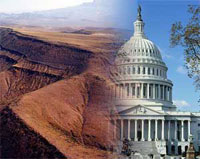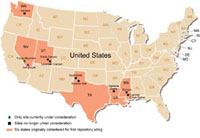 |
 |
 |


During the early eighties,
the Department of Energy looked
at many potential sites for
a repository. The
sites selected for further
study were narrowed down to
nine, then to five,
from five to three, and eventually
to one – Yucca
Mountain. (click to enlarge).
|
 |
 |
 |
|
 |
In 1982, Congress
established a national policy to
solve the problem of nuclear waste
disposal.
This policy is a federal law called the Nuclear Waste Policy Act. Congress based this policy on what most scientists worldwide agreed is the best way to dispose of nuclear waste.
The
Nuclear Waste Policy Act made the U.S.
Department of Energy responsible
for finding a site, building, and
operating an underground disposal
facility called a geologic repository.
In 1983, the U.S. Department of
Energy selected nine locations in
six states for consideration as potential
repository sites. This was based
on data collected for nearly 10 years.
The nine sites were studied and results
of these preliminary studies were
reported in 1985.
Based on these
reports, the president approved three
sites for intensive scientific study
called site characterization. The
three sites were Hanford, Washington;
Deaf Smith County, Texas; and Yucca
Mountain, Nevada.
In 1987, Congress amended the Nuclear
Waste Policy Act and directed U.S.
Department of Energy to study only
Yucca Mountain.
On July 9, 2002, the U.S. Senate
cast the final legislative vote approving
the development of a repository at
Yucca Mountain.
On July 23, 2002, President Bush
signed House Joint Resolution 87,
allowing the DOE to take the next
step in establishing a safe repository
in which to store our nation's nuclear
waste.
On June 3, 2008, the DOE submitted a license application to the Nuclear Regulatory Commission seeking authorization to build the repository.
The Yucca Mountain Project is currently
focused on preparing for the NRC's licensing proceedings.
Last reviewed: 08/08
|